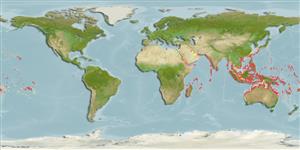Hexacorallia |
Scleractinia |
Faviidae
Environment: milieu / climate zone / Mức độ sâu / distribution range
Sinh thái học
Cùng sống ở rạn san hô; Mức độ sâu 3 - 30 m (Tài liệu tham khảo 8294). Tropical; 36°N - 34°S, 26°E - 137°W (Tài liệu tham khảo 848)
Indo-Pacific.
Length at first maturity / Bộ gần gũi / Weight / Age
Chín muồi sinh dục: Lm ? range ? - ? cm Max length : 100.0 cm COLD con đực/không giới tính; (Tài liệu tham khảo 269)
This is the most commonly of several massive (mound-forming) species with a surface that resembles the maze-like pattern of a mammal brain. The valleys are typically 2 to 3 cm long and 0.5 to 0.6 cm wide. Colonies commonly grow to 1 m diameter or more and are found at all depths (Ref. 269).
Maximum depth from Ref. 98471. Colonies are found at all depths (Ref. 269). In most reef environments, especially found in back reef margins. Subtidal on rocks, rocky reefs, outer reef channel and lagoons (Ref. 98471). Dominant coral of the understory species on Acropora sp. patch reefs (Ref. 102838).
Life cycle and mating behavior
Chín muồi sinh dục | Sự tái sinh sản | Đẻ trứng | Eggs | Sự sinh sản | Larvae
Hermaphroditic (Ref. 113712). Mature gametes are shed into the coelenteron and spawned through the mouth. Life cycle: The zygote develops into a planktonic planula larva. Metamorphosis begins with early morphogenesis of tentacles, septa and pharynx before larval settlement on the aboral end (Ref. 833).
Hodgson, G. 1998 Corals. p. 101-122. In Carpenter, K.E. and V.H. Niem (eds) FAO species identifidication guide for fishery purposes. The living marine resources of the Western Central Pacific. Vol. 1. Seaweeds, coral, bivalves and gastropods. FAO Rome. (Tài liệu tham khảo 269)
IUCN Red List Status
(Tài liệu tham khảo 130435: Version 2025-1)
CITES status (Tài liệu tham khảo 108899)
CMS (Tài liệu tham khảo 116361)
Not Evaluated
Threat to humans
Human uses
| FishSource |
Các công cụ
Thêm thông tin
Sinh thái dinh dưỡngFood items (preys)
Thành phần thức ăn
Thành phần thức ăn
Các động vật ăn mồi
Population dynamicsSự sinh trưởngMax. ages / sizesLength-weight rel.Length-length rel.Length-frequenciesMass conversionSự phong phú PhysiologyThành phần ô-xy
Human RelatedStamps, coins, misc.
Các nguồn internet
Estimates based on models
Preferred temperature
(Ref.
115969): 24.7 - 29.3, mean 28.4 (based on 3473 cells).
Fishing Vulnerability
High vulnerability (60 of 100).
Price category
Unknown.
